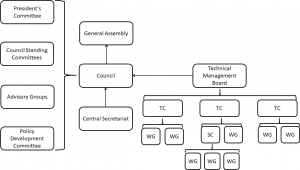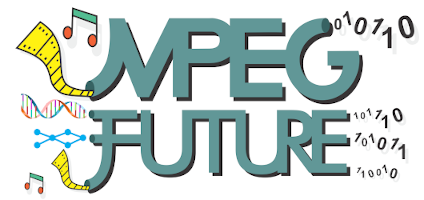MPEG and international standardisation
Standards have a special place in industry because they represent convergence points where the parties involved, who typically are in competition, find it convenient to agree on a single solution.
Standards bodies exists at the international level:
- International Telecommunication Union (ITU) for matters related to telecommunication and broadcasting
- International Electrotechnical Commission (IEC) for electrotechnical matters
- International Organisation for Standardisation (ISO) for everything else.
ITU
The International Telecommunication Union (ITU) is the result of the 1934 merge between the International Telegraph Convention of 1865 and the International Radiotelegraph Convention of 1906, and today is an agency of the United Nations. This is reflected in the two main branches of the ITU: ITU-T and ITU-R. The former deals with standards for global telecommunications excluding radio communication because this is the purview of ITU-R.
IEC
The International Electrotechnical Commission (IEC) is a not-for-profit organisation founded in 1906. It develops International Standards in the fields of electrotechnology, e.g. power generation, transmission and distribution to home appliances and office equipment, semiconductors, fibre optics, batteries, solar energy, nanotechnology and marine energy.
ISO
The International Organization for Standardization (ISO) is an international non-governmental standard-setting organisation founded in 1947 and composed of representatives from various national standards organizations.
ISO is well known for its family of quality management systems standards (ISO 9000), environmental management standards (ISO 14000) and Information Security Management Systems standards (ISO 27000). There are more than 20,000 ISO published standards.
ISO is a huge organisation whose technical branch is structured, as is the IEC’s, in Technical Committees (TC). The first 3 active TCs are: TC 1 Screw threads, TC 2 Fasteners and TC 4 Rolling bearings. The last 3 TCs in order of establishment are TC 322 Sustainable finance, TC 323 Circular economy and TC 324 Sharing economy.
Between these two extremes there is a large number of TCs, e.g., TC 35 Paints and varnishes, TC 186 Cutlery and table and decorative metal hollow-ware, TC 249 Traditional Chinese medicine, TC 282 Water reuse, TC 297 Waste collection and transportation management, etc.
Most TCs are organised in working groups (WG). They are tasked to develop standards while TCs retain key functions such as strategy and management. In quite a few cases the area of responsibility is so broad that a horizontal organisation would not be functional. In this case a TC may decide to establish Subcommittees (SC) which include WGs tasked develop standards.
Figure 1 is an organigram of ISO.

Figure 1 – ISO governance structure
When the MPEG idea took shape in July 1987, the selection of a home to implement the idea was the primary concern. The idea was spoilt for choices as shown by the list of international committees in Table 1 that were created for various reasons – regulation or simply need for an independent technical reference – to cater to the needs of standards by the different industries.
Table 1 – Media-related standards committees (1980’s)
| ITU-T | Speech | SG XV WP 1 |
| Video | SG XV WP 2 | |
| ITU-R | Audio | SG 10 |
| Video | SG 11 | |
| IEC | Recording of audio | SC 60 A |
| Recording of video | SC 60 B | |
| Audio-visual equipment | TC 84 | |
| Receivers | SC 12A and G | |
| ISO | Photography | TC 42 |
| Cinematography | TC 36 |
Since MPEG was conceived to be industry-neutral, committees already developing standards in the “media” area were considered unsuitable because the represented “vested interests”. The choice fell on ISO TC 97 Data Processing who had SC 2 Character sets and Information Coding who included WG 8 Coding of Audio and Picture Information.
In 1987 ISO/TC 97 Data Processing merged with IEC/TC 83 Information technology equipment. The resulting (joint) technical committee was called ISO/IEC JTC 1 Information Technology. SC 2 with its WGs, including WG 8, became part of JTC 1. MPEG was established as an Experts Group on Moving Pictures of ISO/IEC JTC 1/SC 2/WG 8 in 1988.
Note that Experts Group is an organisational entity not officially recognised in the ISO organigram. In 1991 SC 2/WG 8 seceded from SC 2 and became SC 29. WG 8’s Moving Picture Experts Group (MPEG) became WG 11 Coding of audio, picture, multimedia and hypermedia information (but everybody in the industry, and even in the general public, calls it MPEG).
